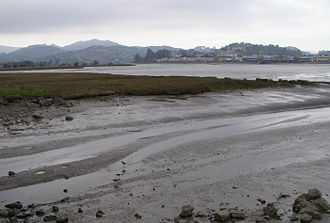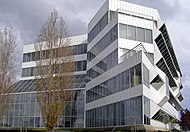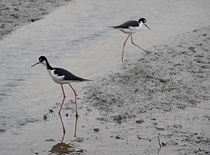Bay mud

Bay mud consists of thick deposits of soft, unconsolidated
Example locations are
Bay mud manifests low
Bay muds often have a high
Bay mud has its own official geological abbreviation:
In relation to
Depositional scenarios

Bay muds originate from two generalized sources. First
Some depositional formation is quite recent, such as in the case of Florida Bay, where much of the bay mud has accumulated since 2000 BCE, and consists of primarily decayed organic material.
Geotechnical factors

Construction on bay mud sites is difficult because of the soil's low strength and high compressibility. Very lightweight buildings can be constructed on bay mud sites if there is a thick enough layer of non-bay-mud soil above the bay mud, but buildings which impose significant loads must be supported on deep foundations bearing on stiffer layers below the bay mud, or obtaining support from friction in the bay mud. Even with deep foundations, difficulties arise because the surrounding ground will likely settle over time, potentially damaging utility connections to the building and causing the entryway to sink below street level.
A number of notable buildings have been constructed over bay muds, typically employing special mitigation designs to withstand seismic risks and settlement issues. Complicating design issues, fill (beginning about 1850 CE) is sometimes found deposited on the surface level. For example, the

Mudflats
When the mud layer is exposed at the tidal fringe, mudflats result affording a unique
Mammals such as the Harbor seal may use mudflats to haul out of estuary waters; however, larger mammals such as humpback whales may become accidentally stranded at low tides. Note that normally humpback whales do not frequent estuaries containing mudflats, but at least one errant whale, publicized by the media as Humphrey the humpback whale, became stuck on a mudflat in San Francisco Bay at Sierra Point in Brisbane, California.
Worldwide occurrences
Bay muds occur in bays and estuaries throughout the temperate regions of the world. In North America, prominent instances are: (a) the Stellwagen Bank formed 16,000 to 9000 BCE by glaciation of Cape Cod Bay in Massachusetts, (b) Florida Bay, (c) in California Morro Bay and San Francisco Bay and (d) Knik & Turnagain Arms in Anchorage, Alaska. In the United Kingdom large bay mud occurrences are found at Morecambe Bay, Bridgwater Bay and Bristol Bay. Straddling Denmark, the Netherlands and Germany is the Wadden Sea, a major formation underlain by bay muds.
In Asia the
Regulatory issues and actions
When building on top of bay mud layers or when
In the case of dredging within the United States, a permit is almost always required from the
For buildings proposed over bay mud layers, typically the municipality involved will, in addition to the usual engineering and design review issues common to all building projects (which are more complicated because of the site conditions), require an Environmental Impact Report [1]. This process would include reviews by that city's building department, as well as applicable regional and state agencies such as those cited above for dredging projects, except that Coast Guard agencies would not typically be concerned. In developing in California, proposed development over bay mud layers would also have to go through a planning commission and a city council in order to be allowed. This process would respect the EIR, CEQA, and all the other bodies discussed above.[8] In the case of San Francisco the project would have to get approved by the San Francisco Board of Supervisors.[9]
In regards to San Francisco, some interesting negative externalities are being experienced due to the dredging of land by the Bay. The Millennium Towers, which were completed in 2008, are currently sinking. This has had a negative impact on the residents of this building. In response to this subsidence, San Francisco's city attorney has decided to file a lawsuit against the developer, because the developer failed to inform the residents of the accelerated speed that the building was sinking at.[10] If this lawsuit results in success for San Francisco this could lead to policy changes being made in the future surrounding transparency between developers and potential buyers of the developed land.
Sea level rise
Sea level rise will have a huge impact on the ecosystems surrounding and within bays all across the globe. Sea level rise in California will completely engulf bay mud that makes up San Francisco Bay. In order to deal with sea level rise the California Coastal Commission has adopted policy guidelines to help California.[11]
See also
References
- ISBN 0-7923-7301-4
- ISBN 1-55369-461-9
- U.S. Geological Survey, (2001)
- ^ R.Kirby and W.R.Parker, Settled mud deposits in Bridgewater Bay Bristol Channel, Report no. 107, Institute of Oceanographic Sciences, Surrey, UK (1980)
- ^ Judges praise innovative ideas, San Francisco Examiner, Page F-6, January 12, 1992
- ^ C.M.Hogan, Kay Wilson, Ballard George, Marc Papineau et al., Environmental Impact Report for the Crowne Plaza Hotel, prepared by Earth Metrics Inc and. published by the city of Burlingame, California, circulated by the State of California Clearinghouse, (1985)
- ISBN 978-1-938-166-02-0.
- ISBN 978-0-415-80988-7.
- ^ "About the Board". Board of Supervisors. City and County of San Francisco. Retrieved 14 November 2016.
- ^ Fuller, Thomas (3 November 2016). "San Francisco Files Lawsuit Against Sinking Millennium Tower". The New York Times. Retrieved 14 November 2016.
- ^ "Sea Level Rise Adopted Policy Guidance". California Coastal Commission. 12 August 2015. Retrieved 14 November 2016.


